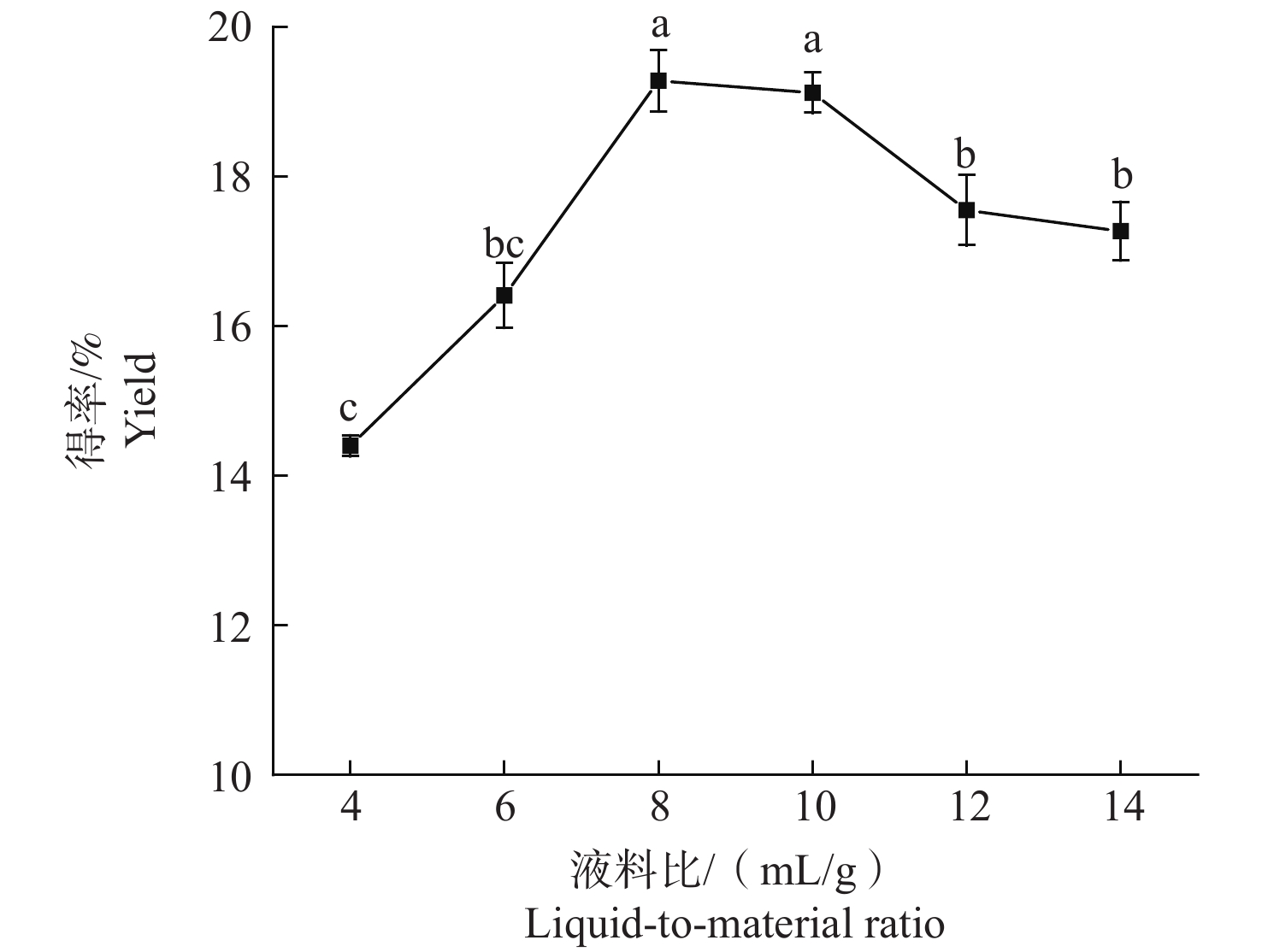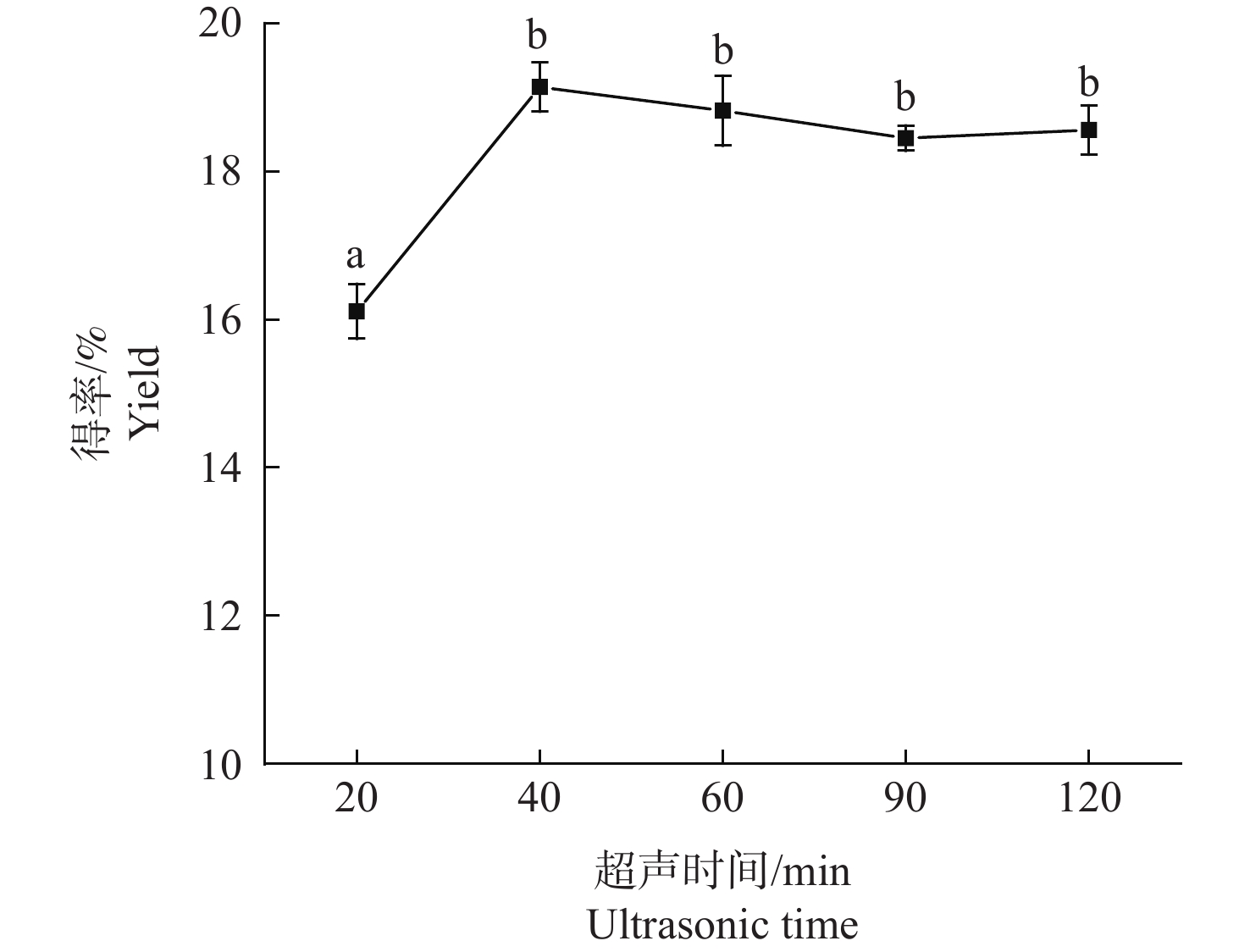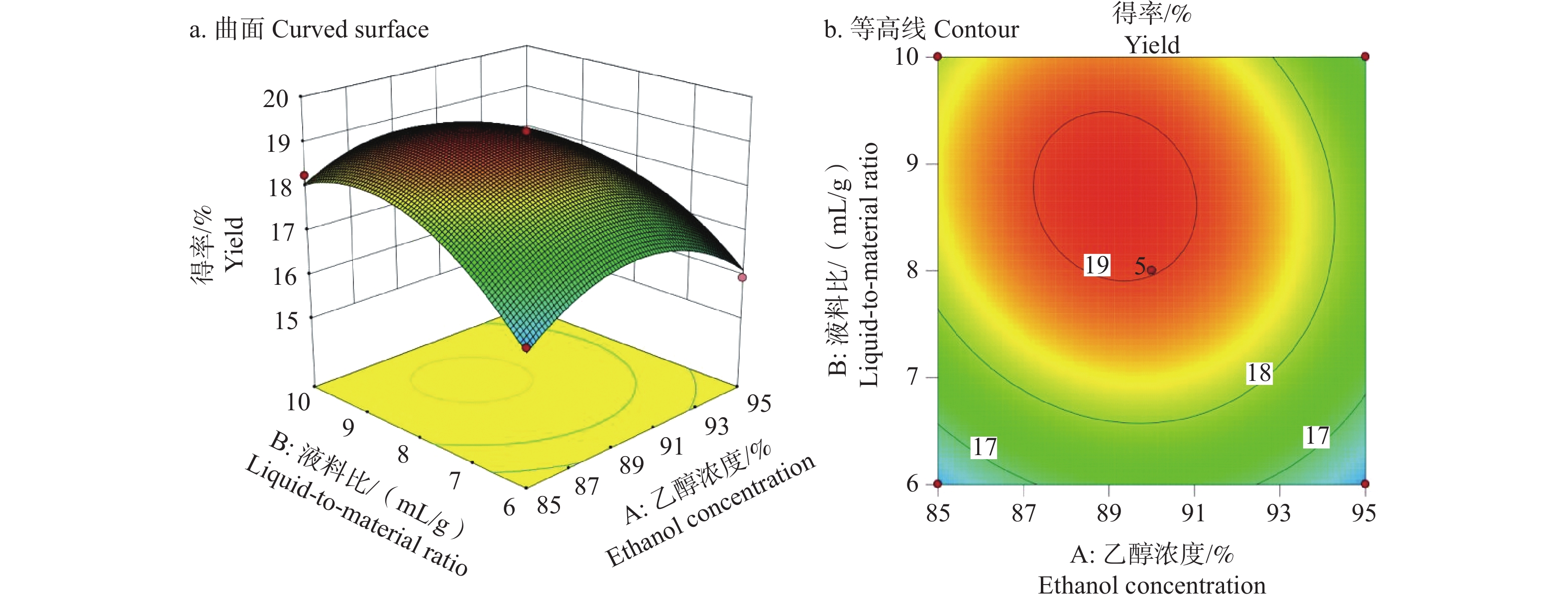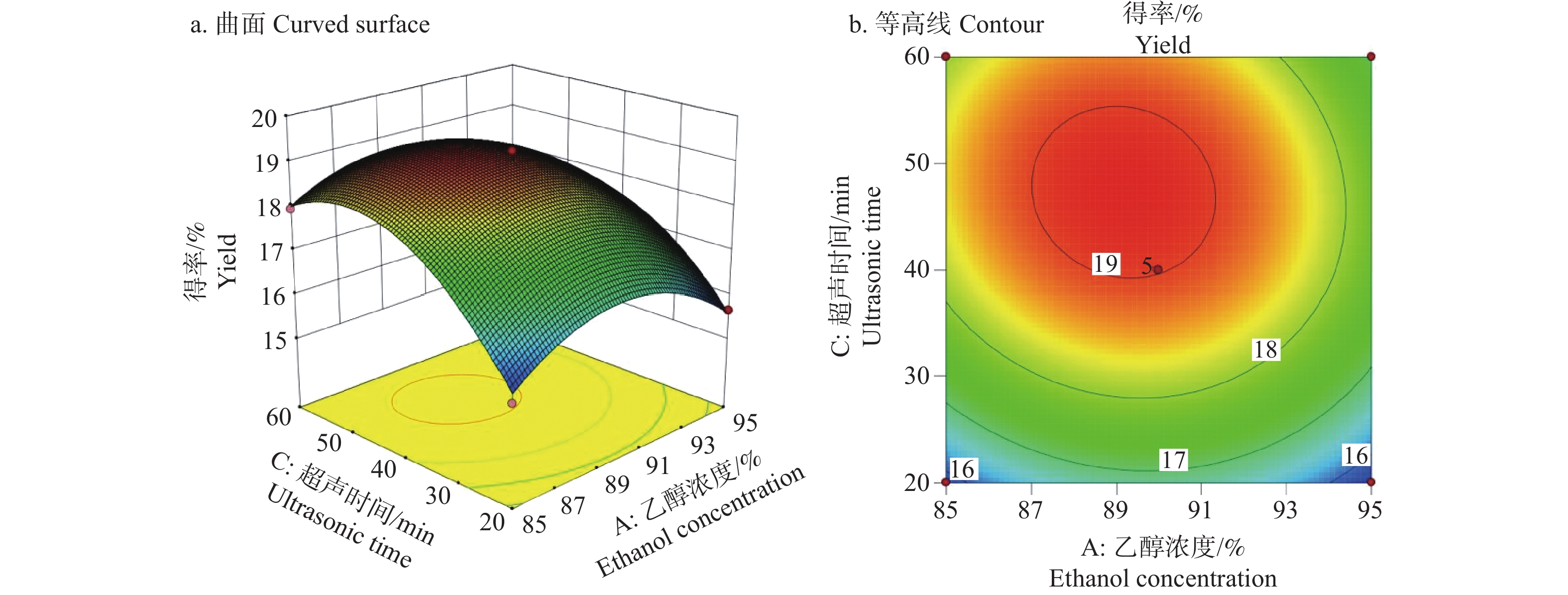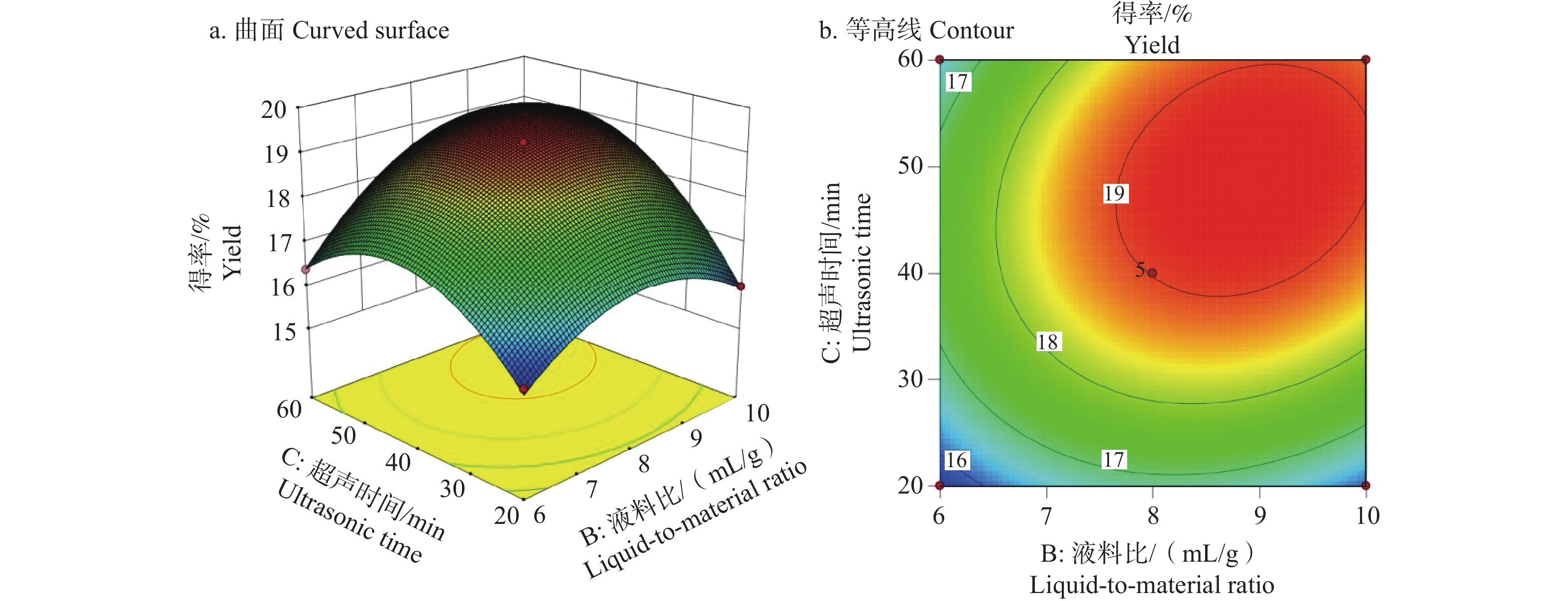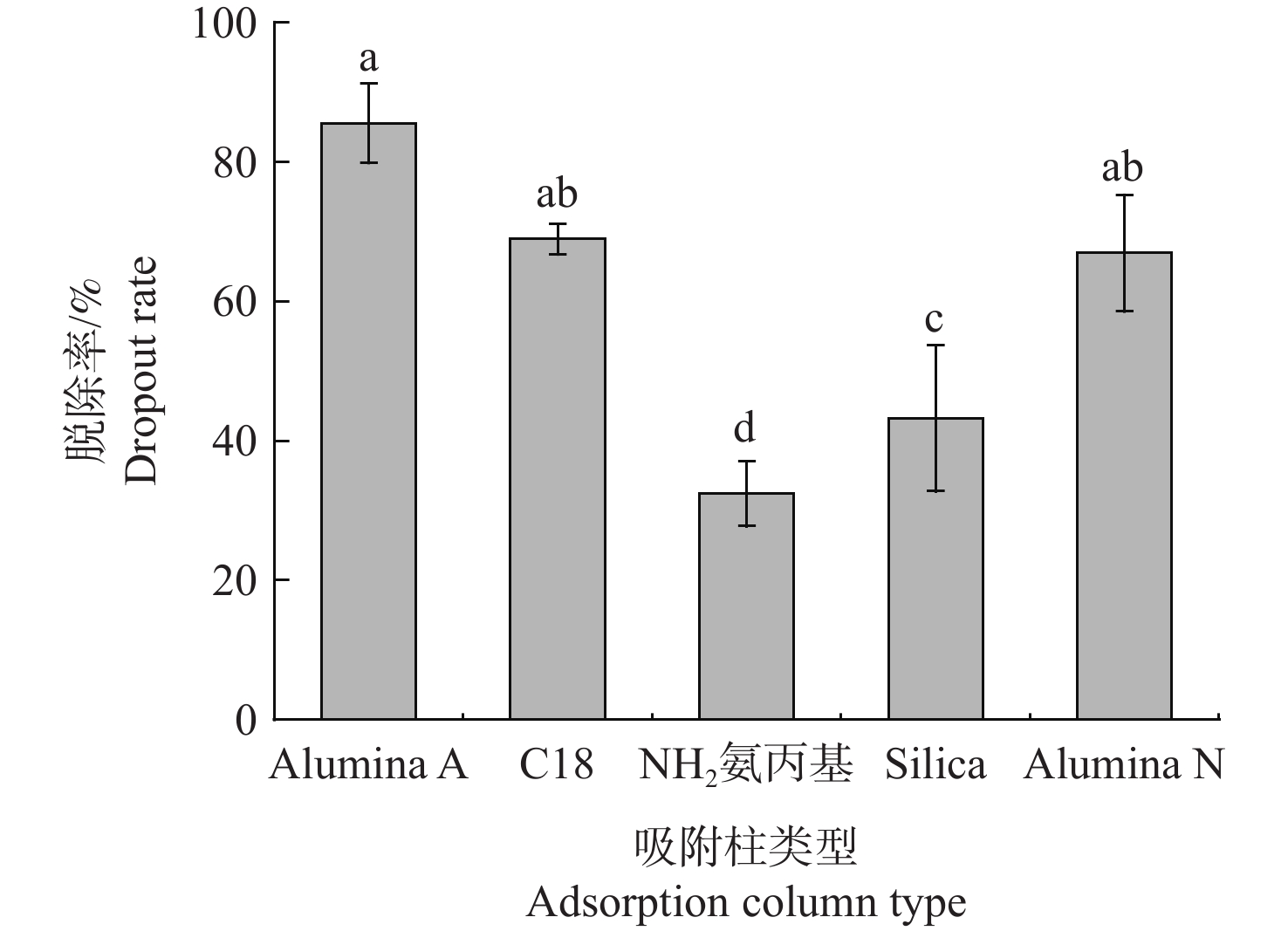Antarctic krill oil extraction process and arsenic removal effect based on response surface method
-
摘要:目的
建立南极磷虾油提取与脱砷的最佳工艺,提高南极磷虾油产品的安全性,为高品质南极磷虾油的工业化生产奠定基础。
方法本文以冷冻南极磷虾粉为原料,采用响应面法优化南极磷虾油的提取工艺,利用原子荧光光度计测定法评价5种吸附材料(Cleanert Silica、Cleanert Alumina N、Cleanert S C18、Cleanert Alumina A、NH2氨丙基吸附柱)对南极磷虾油中砷的脱除效果。在单因素试验基础上,以南极磷虾油得率为响应值,选择乙醇浓度、液料比、超声时间为自变量,对提取的南极磷虾油进行工艺优化,并对其进行脱砷处理。
结果响应面法建立回归方程:X得率=19.02−0.30A+0.68B+0.92C−0.24AB−0.19AC+0.49BC−1.11A2−1.04B2−1.29C2,模型P<0.000 1,失拟项P>0.05,表明该模型极显著且比较稳定,通过模型分析得最佳工艺条件:乙醇浓度
91.1563 %、液料比8.689 2 mL/g、超声时间47.473 4 min。考虑实际应用的可行性,将条件修正为:乙醇浓度91%、液料比8 mL/g、超声时间47 min,得到实际南极磷虾油的得率为18.36%±0.58%,与模型理论预测值18.62%基本一致。以活性氧化铝为介质的Cleanert Alumina A吸附柱可脱除南极磷虾油中82.61%±4.63%的总砷。结论基于响应面法得到的南极磷的Cleanert Alumina A吸附柱可作为未来南极磷虾油脱砷的理想材料。
Abstract:ObjectiveThe present study aims to establish the best technology of extraction and arsenic removal of Antarctic krill oil, improve the safety of Antarctic krill oil products, and lay the foundation for the industrial production of high-quality Antarctic krill oil.
MethodsIn this paper, frozen Antarctic krill powder was used as raw material. The response surface methodology was employed to optimize the extraction rate of Antarctic krill oil, while atomic fluorescence photometry was utilized to assess the effectiveness of arsenic removal from the oil. Building on single-factor tests, the extraction rate of Antarctic krill oil served as the response variable, with ethanol concentration, liquid-to-material ratio, and ultrasonic extraction time selected as independent variables. The extraction process of Antarctic krill oil was optimized, and the arsenic removal efficiency of the krill oil was evaluated.
ResultsThe results indicated that a quadratic polynomial regression equation has been established using the response surface analysis method: Xyield=19.02−0.30A+0.68B+0.92C−0.24AB−0.19AC+0.49BC−1.11A2−1.04B2−1.29C2. The model showed a significance level of P<
0.0001 , and the misfit term had P>0.05, indicating that the model was highly significant and relatively stable. Through model analysis, the optimal conditions were determined to be: ethanol concentration of91.1563 %, liquid-to-material ratio of8.6892 mL/g, and ultrasonic extraction time of47.4734 minutes. Considering practical application feasibility, these conditions were adjusted to an ethanol concentration of 91%, a liquid-to-material ratio of 8 mL/g, and an ultrasonic extraction time of 47 minutes. Under the revised conditions, the actual yield of Antarctic krill oil was found to be 18.36%±0.58%, which was in close agreement with the theoretical prediction of 18.62% from the model. The Cleanert Alumina A SPE column with activated alumina as the medium could remove 82.61%±4.63% of the total arsenic from Antarctic krill oil.ConclusionBased on the response surface methodology, the extraction process for Antarctic krill oil involved using 91% ethanol, a liquid-to-material ratio of 8 mL/g, and an ultrasonic extraction time of 47 minutes. Cleanert Alumina A adsorption columns using activated alumina as a medium can be used as an ideal material for arsenic removal of Antarctic krill oil in the future.
-
南极磷虾(Euphausia superba)资源丰富,且富含磷脂、n-3多不饱和脂肪酸、虾青素、维生素和类黄酮等生物活性物质,是中国海洋战略性新兴产业最值得被开发的重要资源[1-2]。虾油、虾粉、蛋白粉等是以南极磷虾为原料开发的系列产品,其中,南极磷虾油是目前这些产品中最具经济价值的产品,其具有抗炎[3]、改善认知和记忆力[4]、预防心血管[5]、保护神经和抗癌[6-8]等多种作用。然而,中国南极磷虾油中的砷含量较高,总砷含量在1.10~8.33 mg/kg之间[9-10],其中有机砷含量占总砷的95%以上,主要包括砷甜菜碱、砷糖等。目前,尽管GB 2762—2022《食品安全国家标准 食品中污染物限量》对磷虾油产品中总砷的含量未作限量要求,仅对无机砷的含量(≤0.1 mg/kg)进行规定,但已有的研究资料表明,有机砷的毒性仍然具有一定的风险[11]。一些研究也表明,二甲基砷酸会损伤人肺泡细胞、小鼠和兔子的肺细胞和肝细胞、人纤维细胞等不同类型细胞的DNA,造成基因毒性[12]。Fujioka M等[13]在饮用水中加入200 mg/kg二甲基砷(Dimethylarsinic,DMA),并用其喂养妊娠期CD-1小鼠,结果发现DMA增加了小鼠雄性后代肺腺癌(10.0%)和肿瘤癌(33.3%)的发病率。叶紫君[14]和熊海燕[15]通过小鼠试验,都发现有机砷砷甜菜碱在体内可转化为无机砷As(Ⅴ),从而增加了对人体的健康危害。高砷无疑是南极磷虾油产品的安全食用及进一步开发的阻碍因素。
目前,制备南极磷虾油的方法有很多,如超临界CO2流体和亚临界流体萃取技术[16]、有机溶剂提取技术[17]、压榨技术[18]和酶辅助萃取技术[19]等。但这些工业化制备虾油的工艺均未涉及对砷的脱除处理,导致虾油中砷的含量很高,这对产品的食用安全具有潜在的健康风险,因此,有效的脱砷技术对于南极磷虾的商业发展至关重要。方素琼等[20]选用椰壳活性碳和水作为吸附材料,对磷虾油中的有机砷进行脱除,结果表明脱砷率在65%以上,且脱砷前、后磷虾油的主要营养指标未发生明显变化。朱子豪等[21]采用沸石脱除南极磷虾油中的砷,发现钠型沸石对砷的吸附能力较好,且不引入引起磷虾油浑浊的高价离子,磷虾油的安全性高。这些研究为南极磷虾油中砷的脱除提供了方法。为进一步获得更多更合适的脱砷材料,本文在基于响应面法优化南极磷虾油提取工艺的基础上,筛选多种砷吸附材料,探索脱砷效果,建立脱砷南极磷虾油的工艺,旨在提高南极磷虾油产品的安全性,同时为高品质南极磷虾油的工业化生产奠定基础。
1. 材料与方法
1.1 材料
1.1.1 试验原料
南极磷虾于2020年4月采自南极地区,采捕上岸后,立即放入船载冻库−20 ℃冷冻保存;运回实验室后,立即用冷冻干燥机干燥(−53 ℃、0.22 Mpa)48 h,粉碎研磨3 min,过40目筛后,制备成南极磷虾粉,并于−80 ℃下保存备用。
1.1.2 主要试剂
正己烷、甲醇:美国 Tedia 公司;乙醇、浓硝酸、浓硫酸、高氯酸、硫脲、氢氧化钾、硼氢化钾均为国产分析纯:国药集团化学试剂有限公司;NH2氨丙基吸附柱:南京易知源检测技术有限公司;Cleanert Silica、Cleanert S C18、Cleanert Alumina A、Cleanert Alumina N吸附柱:天津博纳艾杰尔科技有限公司。
1.2 仪器与设备
Milli-Q超纯水机(美国 Millipore公司);HETO Power Dry LL 1500冷冻干燥机(美国Thermo 公司);16RXⅡ高速冷冻离心机(日本Hitachi CF公司);冰箱(日本Sanyo公司);AFS-922原子荧光光度计(北京吉天仪器有限公司);B5510E-MT超声波清洗机(美国BRANSON公司);BUCHI R-100旋转蒸发仪(瑞士BUCHI公司);JA12002天平上海精天电子仪器有限公司;Ethos 1/A微波消解仪(意大利Milestone公司);HP-H35SC电加热板(盛达杰森自动化设备有限公司);Supelco吸附柱装置(美国SUPELCO公司)。
1.3 试验方法
1.3.1 总砷含量测定
样品总砷含量测定参照GB 5009.11—2014《食品安全国家标准 食品中总砷及无机砷的测定》[22]。
1.3.2 单因素试验
以有机溶剂乙醇为提取剂,对南极磷虾油进行提取,提取基础条件:虾粉5.00 g、水温30 ℃。固定超声时间40 min、液料比10 mL/g,分别用80%、85%、90%、95%、100%的乙醇浓度作为提取溶剂,考察乙醇浓度对南极磷虾油得率的影响;固定乙醇浓度90%、超声时间40 min,分别考察4、6、8、10、14 mL/g的液料比对南极磷虾油得率的影响;固定乙醇浓度90%、液料比10 mL/g,分别考察20、40、60、90、120 min的超声时间对南极磷虾油得率的影响。提取结束后,4 000 r/min离心5 min,取上清液55 ℃、200 kPa真空浓缩。
1.3.3 响应面试验设计
在单因素试验的基础上,选择对南极磷虾油得率有显著影响的3个因素,根据Box-Behnken进行因素水平试验设计,以南极磷虾油得率为响应值,取−1、0、1代表变量三水平,运用Design-Expert 10.0软件进行数据分析,并建立二次响应面分析模型,拟合得到二次多项式回归方程。
1.3.4 南极磷虾油中砷脱除试验
1)脱砷材料的筛选与确定
吸附材料因表面多孔疏松的结构,而对多种重金属具有极强的吸附能力,从而具有除砷的作用。本文以硅胶、氧化铝、活性碳3种常见吸附材料为基质,选取Cleanert Silica、Cleanert S C18、Cleanert Alumina A、Cleanert Alumina N和NH2氨丙基5种不同类型吸附柱,考察其对南极磷虾中砷的吸附能力,筛选出最佳的吸附材料。先使用4.00 mL正己烷活化萃取柱(500.0 mg,3.0 mL),将相同含量的目标样品上样,使用3.00 mL甲醇进行洗脱,收集洗脱液,用氮气吹至干,再用正己烷复溶至1.00 mL,检测各管中的总砷含量。
2)南极磷虾油中砷的脱除率
将南极磷虾油经吸附柱脱砷后,计算其前后总砷的含量变化,计算公式为:
A=(1 − M1M0)×100 % (1)
式(1)中:A为南极磷虾油中总砷的脱除率,%;M1为脱除后南极磷虾油中总砷的含量,mg/kg;M0为脱除前南极磷虾油中总砷的含量,mg/kg。
1.4 数据统计分析
每组数据至少平行测定3次,试验数据以平均值±标准差表示。使用SPSS 25.0软件进行单因素方差分析,P<0.05表示存在显著差异,P<0.01表示存在极显著差异。采用Design-Experpt 10.0.0和Origin 2018对数据结果进行作图。
2. 结果与讨论
2.1 南极磷虾粉中砷含量及形态组成
经分析,试验南极磷虾粉的总砷含量为(
3.2783 ±0.1359 )mg/kg,其中As(Ⅲ)为(0.1154 ±0.0430 )mg/kg,As(Ⅴ)为(0.1331 ±0.0199 )mg/kg,DMA为(0.0490 ±0.0563 )mg/kg,AsB为(2.9805 )mg/kg。无机砷[As(Ⅲ)和As(Ⅴ)]的含量之和小于0.5 mg/kg,符合国家标准GB 2762—2022对水产品及其制品中无机砷的限量要求;AsB含量占总砷含量的90.93%,说明南极磷虾中主要以AsB为主,这与以往报道的相关结果[23]基本一致。± 0.20822.2 单因素试验结果分析
2.2.1 乙醇浓度对南极磷虾油得率的影响
在提取温度30 ℃、超声时间40 min、液料比8 mL/g、4 000 r/min、离心5 min的条件下,通过改变提取剂乙醇的浓度,探究其对南极磷虾油得率的影响。由图1可知,当乙醇浓度在85%~90%之间时,南极磷虾油的得率较高,最高得率可达19.11%。但考虑到提取剂中的水容易将部分蛋白质和矿物质等水溶性物质提取出来,使南极磷虾油品质下降,且在实际生产中,乙醇的反复利用也会导致其浓度越来越低,而虾粉中的水分含量较低,若从冻虾或水分含量较大的南极磷虾原料中提取虾油,应确保乙醇浓度在85%以上。综合考虑,选择90%乙醇作为南极磷虾油的最佳提取溶剂。
2.2.2 液料比对南极磷虾油得率的影响
由图2可知,当其他反应条件一定时,在液料比4~6 mL/g范围内,随着液料比的增大,南极磷虾油得率从最开始的14.4%,逐渐增大到最高值19.28%;当液料比超过8 mL/g时,随着液料比的增大,南极磷虾油的得率持续下降。这是由于传质平衡的原理,在一定范围内,提取溶剂越多,溶解于溶液的油脂越多[24]。当液料比达到8 mL/g时,提取效果也达到最佳;之后继续增加提取溶剂用量,南极磷虾油的得率反而有所下降。因此,选择8 mL/g作为南极磷虾油提取的最佳液料比,不仅能够节省溶剂的用量,还能减少溶剂残留对南极磷虾油品质的影响。
2.2.3 超声时间对南极磷虾油得率的影响
由图3可知,其他反应条件一定时,在20~40 min范围内,随着超声时间的延长,南极磷虾油的得率从16.11%增加到19.14%;之后在40~120 min范围内,随着超声时间的延长,南极磷虾油得率不发生显著变化;当超声时间为90 min时,南极磷虾油得率有所降低。这是因为在一定的超声时间范围内,超声时间过短会导致磷脂在乙醇中分散不均匀,只能部分溶解油脂;而超声时间过长,又会导致乙醇蒸发量增加,使得已溶解的提取物析出,溶质浓度增大,并且还会导致脂质的氧化[25]。因此,选择40 min作为南极磷虾油提取的最佳超声时间,不仅有利于延长仪器的使用寿命,还能减少超声溶剂残留对南极磷虾油品质的影响。
2.3 响应面试验结果分析
2.3.1 响应面因素水平设计
根据单因素试验结果,选取对南极磷虾油得率有显著影响的3个因素:A乙醇浓度;B液料比;C超声时间,进行因素与水平设计(表1)。
表 1 响应面因素水平表Table 1. Response surface factor level table因素
Factors水平Levels −1 0 1 A乙醇浓度/%
Ethanol concentration85 90 95 B液料比/(mL/g)
Liquid-to-material ratio6 8 10 C超声时间/min
Ultrasonic time20 40 60 2.3.2 响应面设计方案、方差及可信度分析
运用Desig-Experpt 10.0数据分析软件对表2中的试验数据进行多元回归拟合,得到二次多项回归方程:X得率=19.02−0.30A+0.68B+0.92C−0.24AB−0.19AC+0.49BC−1.11A2−1.04B2−1.29C2。
表 2 响应面试验设计及结果Table 2. Response surface test design and results试验号
Experiment number因素Factors 得率/%
YieldA B C 1 −1 −1 0 16.33 2 1 −1 0 15.94 3 −1 1 0 18.27 4 1 1 0 16.91 5 −1 0 −1 15.59 6 1 0 −1 15.65 7 −1 0 1 17.95 8 1 0 1 17.25 9 1 −1 −1 15.70 10 0 1 −1 15.99 11 0 −1 1 16.39 12 0 1 1 18.66 13 0 0 1 18.98 14 0 0 0 19.24 15 0 0 0 18.86 16 0 0 0 18.99 17 0 0 0 19.01 对该模型及回归系数进行统计分析,计算方差、可信度、多元相关系数,结果见表3、表4。由表3、表4可以看出该回归模型P<
0.0001 ,表明模型极显著;失拟项P=0.1178 >0.05,表明模型拟合程度良好;偏差系数<10%,表明模型可信度较高;另外该模型的回归系数R2=0.9908 ,调整后的R2adj=0.9789 ,数值都大于0.9,表明残差相互独立,试验误差较小;测量信噪比21.970,大于4,表明信号充足。以上分析结果表明,该回归模型可用于对南极磷虾油提取条件优化的预测。表 3 拟合二次多项式模型的方差分析及显著性检验Table 3. Analysis of variance and significance test for fitting quadratic polynomial models来源
Sources离差平方和
Sum of squares of dispersion自由度
Degree of freedom均方
Mean squareF值
F valueP值
P value模型Model 31.27 9 3.47 83.61 < 0.0001 **A 0.71 1 0.71 17.18 0.004 3 B 3.74 1 3.74 90.02 < 0.0001 **C 6.70 1 6.70 161.20 < 0.0001 **AB 0.24 1 0.24 5.66 0.048 9* AC 0.14 1 0.14 3.48 0.104 6 BC 0.98 1 0.98 23.59 0.001 8* A2 5.23 1 5.23 125.82 < 0.0001 **B2 4.55 1 4.55 109.45 < 0.0001 **C2 7.03 1 7.03 169.09 < 0.0001 **残差Residuals 0.29 7 0.042 失拟项 Lack of fit 0.21 3 0.071 3.73 0.117 8 纯误差Pure error 0.077 4 0.019 综合Synthesis 31.56 16 注:*表示模型拟合程度差异显著(P<0.05),**表示模型拟合程度差异极显著(P<0.01)。 Notes: * meant model fitting degree was significant difference (P<0.05),** meant model fitting degree was extremely significant difference (P<0.01)。 表 4 拟合二次多项式方程的可信度分析Table 4. Confidence analysis of fitting quadratic polynomial equations项目
Items数值
Value项目
Items数值
Value标准差
Standard deviation0.20 R2 0.990 8 平均值
Mean17.39 调整后的R2
Adjustment R20.978 9 偏差系数
Coefficient of variation1.17% 预测变量结果变化的比例
Prediction R20.887 5 预测误差的平方和
Predicted residual error sum of square3.55 信号与信噪比的度量
Adeq precision21.970 由表3可知,一次项液料比、超声时间及二次项A2、B2、C2对南极磷虾油得率具有极显著的影响(P<0.001),一次项乙醇浓度、交互项AB、BC对南极磷虾油得率具有显著的影响(P<0.05),交互项AC对南极磷虾油得率影响不显著(P>0.05),且交互项作用对南极磷虾油得率的影响程度为BC>AB>AC。
2.3.3 响应面曲线交互作用分析
根据回归方程,乙醇浓度、液料比、超声时间三因素相互作用对南极磷虾油提取效果的影响见图4~图6,响应面曲面图和等高线的形状可以很好地反映各因素之间的相互作用,通过观察等高线的形状和响应面曲面图的陡峭程度,确定两者对响应值的影响程度。等高线的形状越接近椭圆形,曲面图越陡峭,说明两者之间的交互作用越明显[26]。
从图4的椭圆形等高线图可看出,乙醇浓度与液料比交互作用显著;从响应面曲面图可看出,在适当的乙醇浓度和液料比的交互作用下,南极磷虾油的得率具有极大值,极大值在乙醇浓度89%~90%范围内、液料比在8~9 mL/g之间。图5的等高线为圆形,表明乙醇浓度与超声时间交互作用不显著。从图5的响应面曲面可看出,超声时间在20~40 min范围内,南极磷虾油得率不断增大,40 min后,继续延长超声时间,提取效果不再明显;乙醇浓度在85%~90%范围内,南极磷虾油得率变化不明显,继续增大乙醇浓度,得率出现下降;乙醇浓度在90%左右,超声时间在40~50 min范围内,南极磷虾油得率出现极大值。图6的等高线为椭圆形,表明液料比和超声时间交互作用显著,且从响应面曲面图可看出,南极磷虾油得率极大值出现在液料比8~9 mL/g、超声时间40~50 min范围内。以上结果与表4的方差分析数据相符合,且最佳乙醇浓度、液料比和超声时间均在合理的试验范围内。
2.3.4 验证性试验结果
运用Desig-Experpt 10.0数据分析软件优化试验条件,得到预测的最佳条件:乙醇浓度
91.1563 %、液料比8.689 2 mL/g、超声时间47.473 4 min。为验证回归方程模型的可靠性,以及试验实际条件的可行性,将条件修正为乙醇浓度91%、液料比8 mL/g、超声时间47 min,在此最佳条件下进行3次重复试验,得到实际南极磷虾油得率为18.36%±0.58%,与模型理论预测值18.62%基本一致,表明用响应面优化法对南极磷虾油提取最佳工艺的预测准确可行,该回归模型可靠。2.4 南极磷虾油中砷的脱除效果分析
由图7可看出,试验的5种不同类型的吸附柱对南极磷虾油中砷的脱除均有一定的效果,其中Cleanert Alumina A吸附柱对南极磷虾油中砷的脱除效果最佳,脱除率达到82.61%±4.63%,若按照这个脱除率进行脱砷处理,南极磷虾油中的总砷含量将大大降低,产品中有关砷的风险基本得到控制。Cleanert Alumina A吸附柱是以活性氧化铝为关键吸附材料,该材料化学稳定性好,能将南极磷虾油中的砷牢牢地固定在自身表面,进而达到去除砷的目的。Singh T S等[27]利用活性氧化铝除砷,结果发现As(Ⅲ)的去除率可达96.2%,且随着温度的降低,砷的脱除率在不断升高。与其他吸附剂相比,活性氧化铝对有机污染物和无机污染物的亲和力大,重复利用率高[28]。通过试验结果可知,其对南极磷虾油中砷的脱除率在80%以上。未来将以活性氧化铝为介质的吸附剂应用到工业生产中,不仅能够降低成本,而且能有效地提高南极磷虾油产品的质量。
3. 结论
1)在单因素试验的基础上,采用响应面优化的南极磷虾油提取工艺为:乙醇浓度91%、液料比8 mL/g、超声时间47 min,在此条件下南极磷虾油的得率为18.36%±0.58%,与模型理论预测值18.62%基本一致。
2)在最佳南极磷虾油提取工艺的基础上,探讨5种吸附材料的脱砷效果。结果发现,以活性氧化铝为介质的Cleanert Alumina A吸附柱可脱除南极磷虾油中82.61%±4.63%的总砷,是未来南极磷虾油脱砷的理想材料。
-
表 1 响应面因素水平表
Table 1 Response surface factor level table
因素
Factors水平Levels −1 0 1 A乙醇浓度/%
Ethanol concentration85 90 95 B液料比/(mL/g)
Liquid-to-material ratio6 8 10 C超声时间/min
Ultrasonic time20 40 60 表 2 响应面试验设计及结果
Table 2 Response surface test design and results
试验号
Experiment number因素Factors 得率/%
YieldA B C 1 −1 −1 0 16.33 2 1 −1 0 15.94 3 −1 1 0 18.27 4 1 1 0 16.91 5 −1 0 −1 15.59 6 1 0 −1 15.65 7 −1 0 1 17.95 8 1 0 1 17.25 9 1 −1 −1 15.70 10 0 1 −1 15.99 11 0 −1 1 16.39 12 0 1 1 18.66 13 0 0 1 18.98 14 0 0 0 19.24 15 0 0 0 18.86 16 0 0 0 18.99 17 0 0 0 19.01 表 3 拟合二次多项式模型的方差分析及显著性检验
Table 3 Analysis of variance and significance test for fitting quadratic polynomial models
来源
Sources离差平方和
Sum of squares of dispersion自由度
Degree of freedom均方
Mean squareF值
F valueP值
P value模型Model 31.27 9 3.47 83.61 < 0.0001 **A 0.71 1 0.71 17.18 0.004 3 B 3.74 1 3.74 90.02 < 0.0001 **C 6.70 1 6.70 161.20 < 0.0001 **AB 0.24 1 0.24 5.66 0.048 9* AC 0.14 1 0.14 3.48 0.104 6 BC 0.98 1 0.98 23.59 0.001 8* A2 5.23 1 5.23 125.82 < 0.0001 **B2 4.55 1 4.55 109.45 < 0.0001 **C2 7.03 1 7.03 169.09 < 0.0001 **残差Residuals 0.29 7 0.042 失拟项 Lack of fit 0.21 3 0.071 3.73 0.117 8 纯误差Pure error 0.077 4 0.019 综合Synthesis 31.56 16 注:*表示模型拟合程度差异显著(P<0.05),**表示模型拟合程度差异极显著(P<0.01)。 Notes: * meant model fitting degree was significant difference (P<0.05),** meant model fitting degree was extremely significant difference (P<0.01)。 表 4 拟合二次多项式方程的可信度分析
Table 4 Confidence analysis of fitting quadratic polynomial equations
项目
Items数值
Value项目
Items数值
Value标准差
Standard deviation0.20 R2 0.990 8 平均值
Mean17.39 调整后的R2
Adjustment R20.978 9 偏差系数
Coefficient of variation1.17% 预测变量结果变化的比例
Prediction R20.887 5 预测误差的平方和
Predicted residual error sum of square3.55 信号与信噪比的度量
Adeq precision21.970 -
[1] Wang Z W, Liu F J, Luo Y, et al. Effects of tea polyphenol and its combination with other antioxidants added during the extraction process on oxidative stability of Antarctic krill (Euphausia superba) oil[J]. Foods, 2022, 11(23): 3768. DOI: 10.3390/foods11233768
[2] Xie D, Gong M Y, Wei W, et al. Antarctic krill (Euphausia superba) oil: a comprehensive review of chemical composition, extraction technologies, health benefits, and current applications[J]. Comprehensive Reviews in Food Science and Food Safety, 2019, 18(2): 514 − 534. DOI: 10.1111/1541-4337.12427
[3] 郑振霄,朱凯,戴志远. 南极磷虾油对脂多糖诱导RAW264.7细胞炎症反应的抑制作用[J]. 中国食品学报,2023,23(1):23 − 31. Zheng Z X, Zhu K, Dai Z Y. Inhibitory effect of Antarctic krill oil on LPS induced inflammatory response in RAW246.7 cells[J]. Journal of Chinese Institute of Food Science and Technology, 2023, 23(1): 23 − 31.
[4] Wang C C, Kong J Y, Li X Y, et al. Antarctic krill oil exhibited synergistic effects with nobiletin and theanine in ameliorating memory and cognitive deficiency in SAMP8 mice: applying the perspective of the sea-land combination to retard brain aging[J]. Frontiers in Aging Neuroscience, 2022, 14: 964077. DOI: 10.3389/fnagi.2022.964077
[5] Hals P A, Wang X L, Xiao Y F. Effects of a purified krill oil phospholipid rich in long-chain omega-3 fatty acids on cardiovascular disease risk factors in non-human primates with naturally occurring diabetes type-2 and dyslipidemia[J]. Lipids in Health and Disease, 2017, 16(1): 11. DOI: 10.1186/s12944-017-0411-z
[6] 郭梦杰,刘云,吴志强,等. 南极磷虾油对利血平诱导的斑马鱼抑郁模型的改善作用[J]. 食品与机械,2023,39(7):152 − 156,171. Guo M J, Liu Y, Wu Z Q, et al. Improvement of Antarctic krill oil on reserpine induced zebrafish depression model[J]. Food & Machinery, 2023, 39(7): 152 − 156, 171.
[7] Jayathilake A G, Kadife E, Luwor R B, et al. Krill oil extract suppresses the proliferation of colorectal cancer cells through activation of caspase 3/9[J]. Nutrition & Metabolism, 2019, 16: 53.
[8] Su X, Tanalgo P, Bustos M, et al. The effect of krill oil and N-3 polyunsaturated fatty acids on human osteosarcoma cell proliferation and migration[J]. Current Drug Targets, 2018, 19(5): 479 − 486. DOI: 10.2174/1389450116666150107152206
[9] 郭莹莹,王联珠,朱文嘉,等. 南极磷虾及其产品中砷含量分析及安全性评价[J]. 食品科学,2018,39(19):182 − 187. DOI: 10.7506/spkx1002-6630-201819028 Guo Y Y, Wang L Z, Zhu W J, et al. Arsenic content analysis and safety evaluation of Antarctic krill (Euphausia superba) and its products[J]. Food Science, 2018, 39(19): 182 − 187. DOI: 10.7506/spkx1002-6630-201819028
[10] 王松,Li K,崔鹤,等. 南极磷虾油中总砷含量及砷形态分析[J]. 分析化学,2016,44(5):767 − 772. DOI: 10.11895/j.issn.0253-3820.150942 Wang S, Li K, Cui H, et al. Quantitative analysis of total and different species of arsenic in oil of Antarctic krill (Euphausia superba)[J]. Chinese Journal of Analytical Chemistry, 2016, 44(5): 767 − 772. DOI: 10.11895/j.issn.0253-3820.150942
[11] Zhou Q, Xi S H. A review on arsenic carcinogenesis: epidemiology, metabolism, genotoxicity and epigenetic changes[J]. Regulatory Toxicology and Pharmacology, 2018, 99: 78 − 88. DOI: 10.1016/j.yrtph.2018.09.010
[12] Mourón S A, Grillo C A, Dulout F N, et al. DNA-protein cross-links and sister chromatid exchanges induced by dimethylarsinic acid in human fibroblasts cells[J]. Mutation Research/Genetic Toxicology and Environmental Mutagenesis, 2005, 581(1 − 2): 83 − 90. DOI: 10.1016/j.mrgentox.2004.11.001
[13] Fujioka M, Suzuki S, Gi M, et al. Dimethylarsinic acid (DMA) enhanced lung carcinogenesis via histone H3k9 modification in a transplacental mouse model[J]. Archives of Toxicology, 2020, 94(3): 927 − 937. DOI: 10.1007/s00204-020-02665-x
[14] 叶紫君. 砷甜菜碱在海洋青鳉鱼和小鼠体内的代谢过程[D]. 广州:广州大学,2023. Ye Z J. Metabolic processes of arsenobetaine in the marine medaka and mouse[D]. Guangzhou: Guangzhou University, 2023.
[15] 熊海燕. 砷在海洋鱼与小鼠体内的生物转化及其生态和健康风险指示[D]. 广州:广州大学,2021. Xiong H Y. The biotransformation of arsenic in marine fish and mice and its ecological and health risk indication[D]. Guangzhou: Guangzhou University, 2021.
[16] Liu S L, Hu W, Fang Y Z, et al. Extraction of oil from wet Antarctic krill (Euphausia superba) using a subcritical dimethyl ether method[J]. RSC Advances, 2019, 9(59): 34274 − 34282. DOI: 10.1039/C9RA06238F
[17] Xie D, Mu H Y, Tang T P, et al. Production of three types of krill oils from krill meal by a three-step solvent extraction procedure[J]. Food Chemistry, 2018, 248: 279 − 286. DOI: 10.1016/j.foodchem.2017.12.068
[18] 刘志东,陈雪忠,李斌,等. 制备方法对南极磷虾油品质的影响[J]. 现代食品科技,2017,33(1):191 − 196. Liu Z D, Chen X Z, Li B, et al. Effect of extraction methods on quality of Antarctic krill (Euphausia superba) oil[J]. Modern Food Science and Technology, 2017, 33(1): 191 − 196.
[19] 俞喜娜,陈康,张燕平,等. 酶辅助提取南极磷虾磷脂及脂质组学研究[J]. 中国食品学报,2020,20(11):97 − 106. Yu X N, Chen K, Zhang Y P, et al. Enzyme-assisted extraction of phospholipids from Antarctic krill and it’s lipidomics[J]. Journal of Chinese Institute of Food Science and Technology, 2020, 20(11): 97 − 106.
[20] 方素琼,朱东奇,林锦淮,等. 磷虾油中有机砷脱除工艺优化[J]. 食品研究与开发,2024,45(9):111 − 117. DOI: 10.12161/j.issn.1005-6521.2024.09.016 Fang S Q, Zhu D Q, Lin J H, et al. Removal process optimization of organic arsenic from krill oil[J]. Food Research and Development, 2024, 45(9): 111 − 117. DOI: 10.12161/j.issn.1005-6521.2024.09.016
[21] 朱子豪,邓尚贵,李钰金,等. 南极磷虾油脱砷效果[J]. 食品工业,2019,40(7):73 − 76. Zhu Z H, Deng S G, Li Y J, et al. The effect of removing arsenic from Antarctic krill oil[J]. The Food Industry, 2019, 40(7): 73 − 76.
[22] 中华人民共和国国家卫生和计划生育委员会. 食品中总砷及无机砷的测定:GB 5009.11—2014[S]. 北京:中国标准出版社,2016. National Health and Family Planning Commission of the People’s Republic of China. Determination of total arsenic and inorganic arsenic in food: GB 5009.11—2014[S]. Beijing: Standards Press of China, 2016.
[23] Mirzoeva N, Tereshchenko N, Paraskiv A, et al. Metals and metalloids in Antarctic krill and water in deep Weddell Sea areas[J]. Marine Pollution Bulletin, 2022, 178: 113624. DOI: 10.1016/j.marpolbul.2022.113624
[24] 孙维维,姜晓明,徐杰,等. 太平洋磷虾油提取工艺优化及与南极磷虾油品质的比较[J]. 中国油脂,2018,43(1):8 − 12. DOI: 10.3969/j.issn.1003-7969.2018.01.003 Sun W W, Jiang X M, Xu J, et al. Optimization of extraction process of Pacific krill oil and quality comparison with Antarctic krill oil[J]. China Oils and Fats, 2018, 43(1): 8 − 12. DOI: 10.3969/j.issn.1003-7969.2018.01.003
[25] 刘芸杭,林伟,胥亚夫,等. 南极磷虾油的分级制备及其品质分析[J]. 水产学报,2022,46(3):457 − 465. Liu Y H, Lin W, Xu Y F, et al. Fractional preparation of Antarctic krill oil and its quality analysis[J]. Journal of Fisheries of China, 2022, 46(3): 457 − 465.
[26] 周庆新,谷彩霞,陈芳甜,等. 南极磷虾油醇提工艺优化及其虾青素热稳定性研究[J]. 食品工业科技,2023,44(1):233 − 241. Zhou Q X, Gu C X, Chen F T, et al. Optimization of alcohol extraction process of Antarctic krill oil and study on thermal stability of astaxanthins[J]. Science and Technology of Food Industry, 2023, 44(1): 233 − 241.
[27] Singh T S, Pant K K. Equilibrium, kinetics and thermodynamic studies for adsorption of As (Ⅲ) on activated alumina[J]. Separation and Purification Technology, 2004, 36(2): 139 − 147. DOI: 10.1016/S1383-5866(03)00209-0
[28] 孙丽凤. 活性氧化铝对As(Ⅲ)和As(Ⅴ)的吸附性能研究[J]. 土木建筑与环境工程,2014,36(4):121 − 126. Sun L F. Adsorption behavior of As (Ⅲ) and As (Ⅴ) by activated aluminum[J]. Journal of Civil, Architectural & Environmental Engineering, 2014, 36(4): 121 − 126.



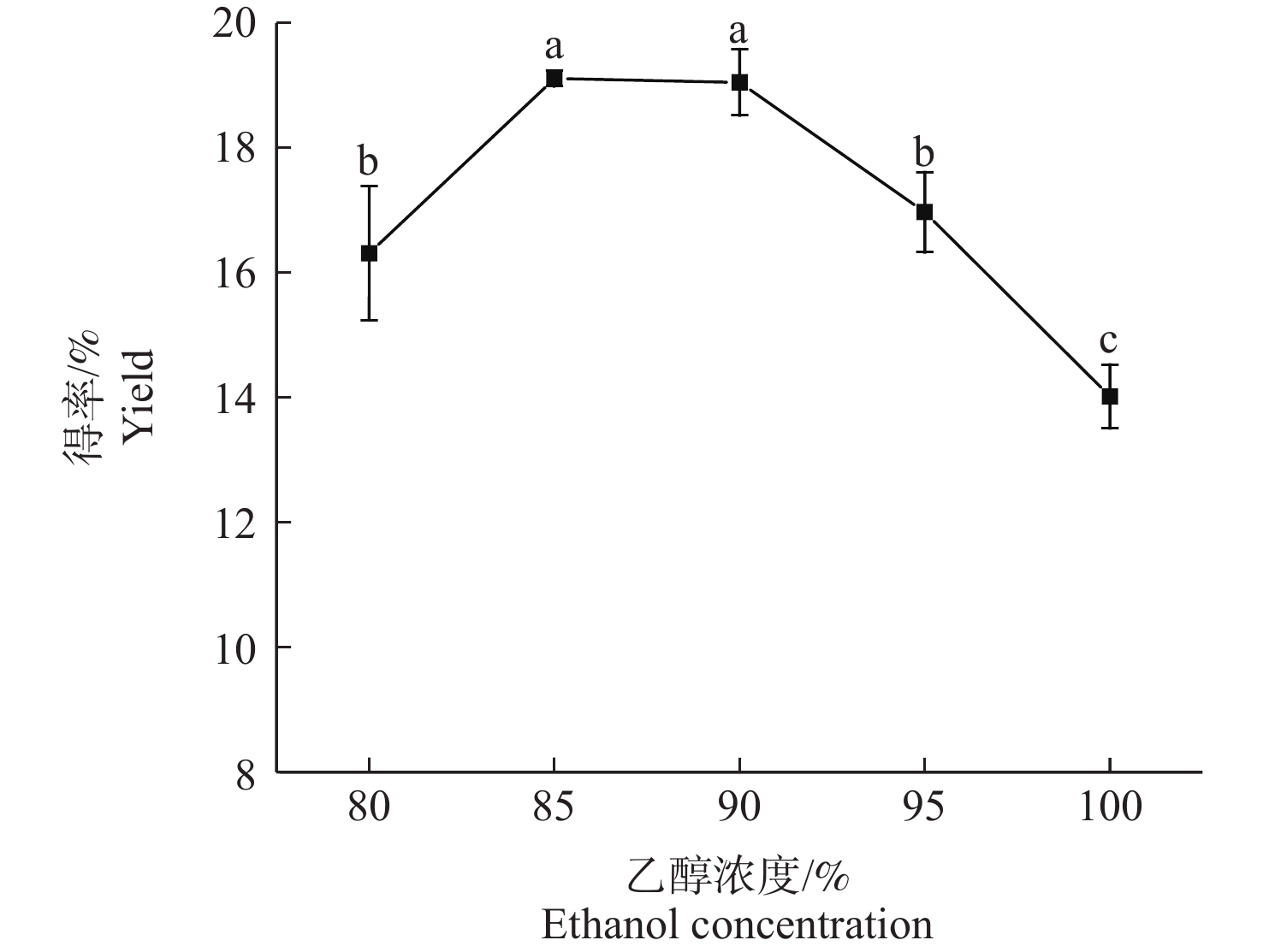
 下载:
下载:
